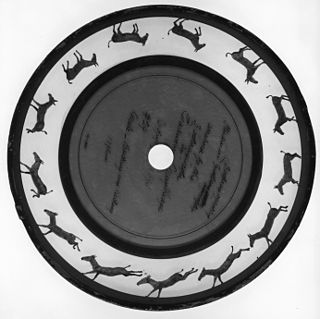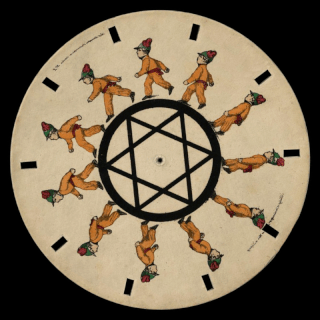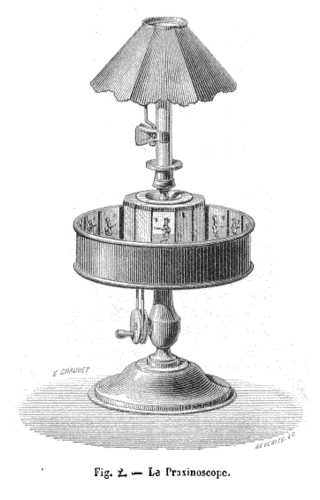Related Research Articles

Eadweard Muybridge was an English photographer known for his pioneering work in photographic studies of motion, and early work in motion-picture projection.

The zoopraxiscope is an early device for displaying moving images and is considered an important predecessor of the movie projector. It was conceived by photographic pioneer Eadweard Muybridge in 1879. Muybridge used the projector in his public lectures from 1880 to 1895. The projector used 16" glass disks onto which Muybridge had an unidentified artist paint the sequences as silhouettes. This technique eliminated the backgrounds and enabled the creation of fanciful combinations and additional imaginary elements. Only one disk used photographic images, of a horse skeleton posed in different positions. A later series of 12″ discs, made in 1892–1894, used outlines drawn by Erwin F. Faber that were printed onto the discs photographically, then colored by hand. These colored discs were probably never used in Muybridge's lectures. All images of the known 71 disks, including those of the photographic disk, were rendered in elongated form to compensate the distortion of the projection. The projector was related to other projecting phenakistiscopes and used some slotted metal shutter discs that were interchangeable for different picture disks or different effects on the screen. The machine was hand-cranked.

The phenakistiscope was the first widespread animation device that created a fluid illusion of motion. Dubbed Fantascope and Stroboscopische Scheiben by its inventors, it has been known under many other names until the French product name Phénakisticope became common. The phenakistiscope is regarded as one of the first forms of moving media entertainment that paved the way for the future motion picture and film industry. Similar to a GIF animation, it can only show a short continuous loop.

The praxinoscope was an animation device, the successor to the zoetrope. It was invented in France in 1877 by Charles-Émile Reynaud. Like the zoetrope, it used a strip of pictures placed around the inner surface of a spinning cylinder. The praxinoscope improved on the zoetrope by replacing its narrow viewing slits with an inner circle of mirrors, placed so that the reflections of the pictures appeared more or less stationary in position as the wheel turned. Someone looking in the mirrors would therefore see a rapid succession of images producing the illusion of motion, with a brighter and less distorted picture than the zoetrope offered.
The decade of the 1870s in film involved some significant events.

The Horse in Motion is a series of cabinet cards by Eadweard Muybridge, including six cards that each show a sequential series of six to twelve "automatic electro-photographs" depicting the movement of a horse. Muybridge shot the photographs in June 1878. An additional card reprinted the single image of the horse "Occident" trotting at high speed, which had previously been published by Muybridge in 1877.

Palo Alto Stock Farm Horse Barn, also known as Stanford Red Barn or Stanford Stables, is located at present-day address 621 Fremont Road in Stanford, California. This barn was established c.1878-1880 and is an example of Victorian-era Stick-Eastlake style architecture, though the architect is unknown. Palo Alto Stock Farm Horse Barn has been listed on the National Register of Historic Places since 1985. There are only two original buildings left from the Palo Alto Stock Farm: the red barn and the brick stable.
For the history of animation after the development of celluloid film, see history of animation.

Animal Locomotion: An Electro-photographic Investigation of Consecutive Phases of Animal Movements is a series of scientific photographs by Eadweard Muybridge made in 1884 and 1885 at the University of Pennsylvania, to study motion in animals. Published in July 9, 1887, the chronophotographic series comprised 781 collotype plates, each containing up to 36 pictures of the different phases of a specific motion of one subject.
Events in 1885 in animation.
Events in 1884 in animation.
Events in 1883 in animation.
Events in 1882 in animation.
Events in 1880 in animation.
Events in 1878 in animation.
Events in 1877 in animation.
Events in 1873 in animation.
Events in 1872 in animation.
References
- ↑ "Le Praxinoscope à projection". emilereynaud.fr (in French). Retrieved 2019-07-25.
- ↑ "Eadweard Muybridge: Defining Modernities". Arts and Humanities Research Council, Kingston University, London. Retrieved 26 February 2022.
- ↑ "Motion Pictures: The Zoopraxiscope". Tate Museum. Retrieved 26 February 2022.
- ↑ "The horse in motion, illus. by Muybridge. "Sallie Gardner", owned by Leland Stanford, running at a 1:40 gait over the Palo Alto track, 19 June 1878: 2 frames showing diagram of foot movements". Library of Congress. Retrieved 2020-03-30.
- ↑ Braun, Marta (2012-01-01). Eadweard Muybridge. Reaktion Books. ISBN 978-1-78023-000-9.
- ↑ Bendazzi, Giannalberto (1994). Cartoons: One hundred years of cinema animation . Translated by Anna Taraboletti-Segre. Indiana University Press. p. 26. ISBN 0-253-20937-4.
- ↑ Herbst, Helmut. Drei Bildbeschreibungen und eine Liste. Der Filmpionier Guido Seeber. pp. 15–41 in C. Müller und H. Segeberg (ed.) Die Modellierung des Kinofilms. Munich, 1998.
- ↑ Stiftung Deutsche Kinemathek (publ.) Das wandernde Bild. Der Filmpionier Guido Seeber. Berlin, 1979.
- ↑ "Animation from Van Beuren Studios". Turner Classic Movies. Archived from the original on August 26, 2018. Retrieved August 25, 2018.
- ↑ A. J. VAN BEUREN, 58, FILM OFFICIAL, DIES. New York Times. November 13, 1938, Sunday p 45
- ↑ THEATER GOSSIP. Evening Independent - Google News Archive - Feb 20, 1938
- ↑ Daniel Robbins, Grove Art Online, Oxford University Press, MoMA, 2009
- ↑ Daniel Meyer-Dinkgräfe, European Culture in a Changing World: Between Nationalism and Globalism, Cambridge Scholars Press, 2004
- ↑ "J.R. Bray". lambiek.net. Retrieved May 20, 2020.
- ↑ Grant, John (2001). Masters of Animation. Batsford Books. p. 48. ISBN 9780713486285 . Retrieved 2022-05-16– via Google Books.
- ↑ Lund, Karen (June 1999). "Innovative Animators". Information Bulletin. Library of Congress . Retrieved 2022-05-16.
- ↑ Clarke, James (2007). Animated Films. Virgin Books. pp. 13. ISBN 978-0753512586.
- ↑ Barrier, Michael (1999). Hollywood Cartoons: American Animation in Its Golden Age. Oxford University Press. p. 11. ISBN 9780198020790.
- ↑ Kanfer, Stefan (2000). Serious Business: The Art and Commerce of Animation in America from Betty Boop to Toy Story. Da Capo Press. p. 48. ISBN 978-0306809187 . Retrieved 25 January 2020.
- ↑ Kroon, Richard W. (2010). A/V A to Z: An Encyclopedic Dictionary of Media, Entertainment, and Other Audiovisual Terms. McFarland. p. 46. ISBN 9780786444052.
- ↑ Robertson, Patrick (November 11, 2011). Robertson's Book of Firsts: Who Did What for the First Time. Bloomsbury Publishing. p. 326. ISBN 9781608197385 . Retrieved May 29, 2015.
- ↑ Crafton, Donald (1993). Before Mickey: The Animated Film 1898-1928. University of Chicago Press. p. 376. ISBN 9780226116679.
- ↑ "John R. Bray, 99, film pioneer". The Philadelphia Inquirer . Bridgeport, Connecticut. Associated Press. 1978-10-12. p. 42. Retrieved 2022-05-16– via Newspapers.com.
- ↑ "Angel Espoy". Broadmoor Galleries. Retrieved September 4, 2021.
- ↑ Eisner, Judith A. (September 24, 1970). "The fabulous career Byington Ford". archive.org. Carmel Pine Cone. Retrieved April 11, 2020.
- ↑ "Espoy (Seal Beach)". Press-Telegram. Long Beach, California. January 13, 1963. p. 18 – via newspapers.com.